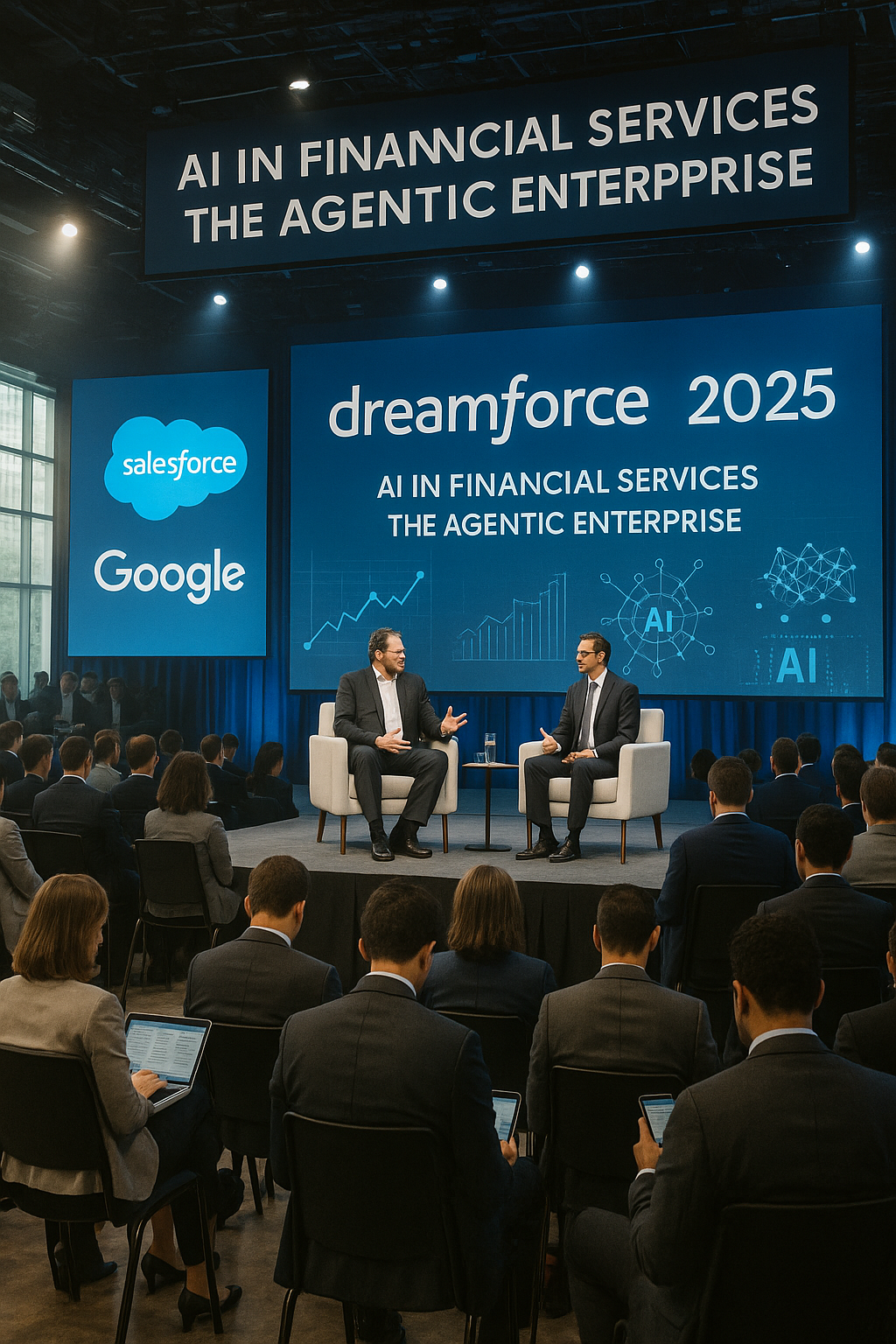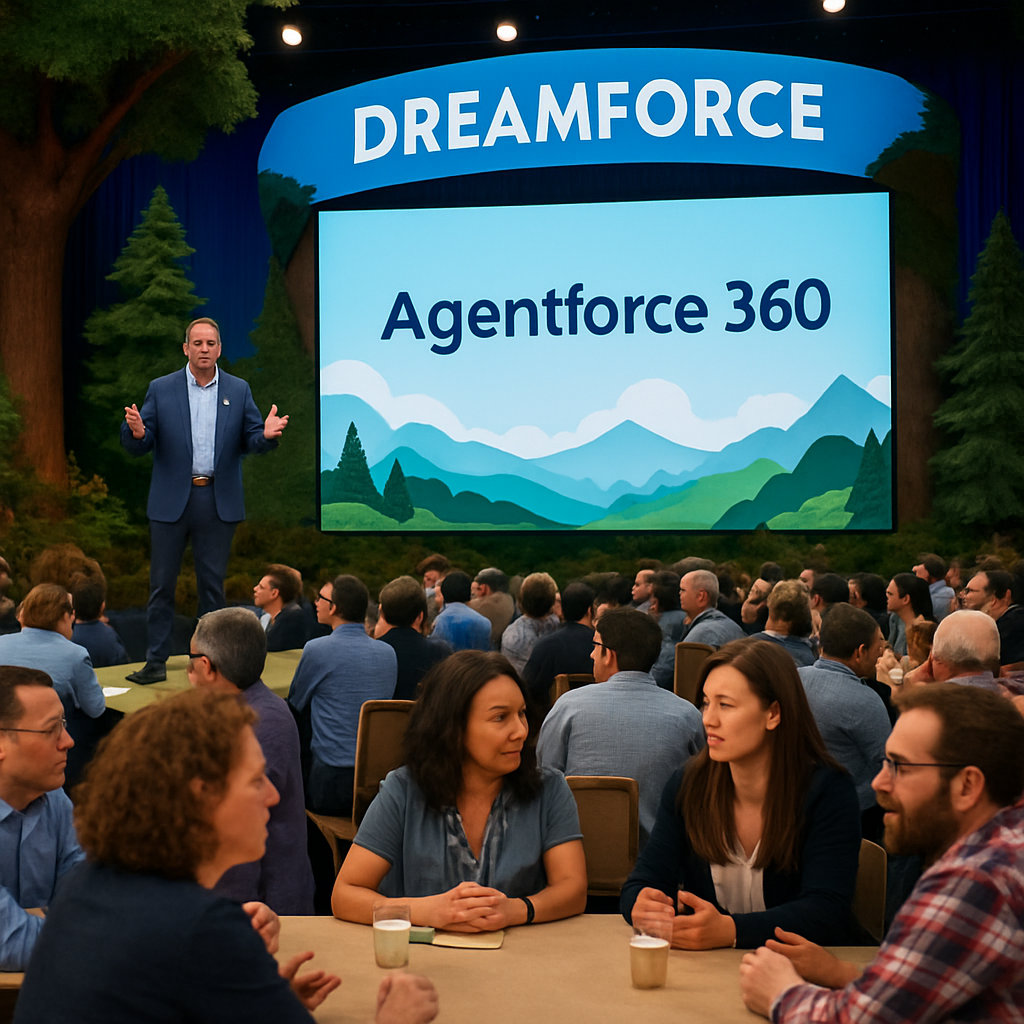
Strategic Implications of the Agentic Enterprise for Financial Services
How Agentforce 360 is Transforming Banking, Wealth Management, and Insurance
If Tuesday was about the launch and Wednesday was about the applications, Thursday at Dreamforce 2025 was about the strategic implications—the decisions financial services leaders need to make now to position their organizations for the Agentic Enterprise era.
This morning's conversation between Sundar Pichai (CEO of Google and Alphabet) and Marc Benioff (CEO of Salesforce) wasn't just another fireside chat between tech executives. It was a glimpse into how the foundational technologies of enterprise AI—large language models, cloud infrastructure, data platforms, and application layers—are converging to reshape every industry, with financial services at the forefront.
Combined with insights from today's IT Governance, MuleSoft, and Customer Success keynotes, a clear strategic picture emerged: the financial institutions that thrive in the next decade won't be those with the most AI agents. They'll be the organizations that build the right foundation for AI to operate safely, effectively, and at scale.
Let me break down the most important strategic insights from Day 3 and what they mean for your planning.
The Pichai-Benioff Conversation: Three Strategic Pillars for Financial Services
The session I anticipated most this week did not disappoint. Watching two leaders who've shaped the technology landscape discuss the future of enterprise AI provided clarity on where the industry is heading—and what that means for financial services specifically.
Pillar 1: Model Flexibility is a Strategic Imperative
One of the most significant announcements embedded in this conversation was the deepening of the Google Cloud and Salesforce partnership, specifically around Google's Gemini AI models integration with Agentforce 360.
Sundar Pichai emphasized Google's commitment to making Gemini the most capable and trustworthy AI for enterprise use. The technical capabilities he highlighted are directly relevant to financial services:
Gemini 2.0's "Think" feature enables deeper reasoning on complex problems—exactly what financial services needs for tasks like credit risk assessment, portfolio optimization, and claims adjudication where simple pattern matching isn't sufficient.
Multimodal capabilities allow Gemini to process text, images, video, and audio in combination—critical for use cases like mortgage document processing (where you need to analyze statements, tax returns, appraisals, and property photos) or insurance claims (where photos, repair estimates, and policy documents must be evaluated together).
Long context windows mean Gemini can analyze comprehensive customer relationships across years of interaction history—essential for wealth management and private banking where deep client knowledge drives better advice.
Here's what matters strategically: Agentforce 360 isn't locked into a single AI model. Organizations can choose between Anthropic's Claude, OpenAI's GPT models, and Google's Gemini based on the specific requirements of each use case.
For financial services, this flexibility addresses a critical concern: regulatory compliance. Different use cases may have different regulatory requirements. Some might require models that can provide detailed explanations of their reasoning (for fair lending compliance). Others might prioritize privacy protections (for customer data handling). Still others might require specific performance characteristics (for fraud detection speed).
A multi-model strategy gives you options rather than locking you into a single vendor's approach—a lesson the financial services industry learned painfully with legacy core systems.
Pillar 2: The Trust Architecture Matters More Than the Models
Both CEOs spent significant time on trust—and they should. For financial services, AI without trust is AI that can't be deployed.
Marc Benioff emphasized that Salesforce's differentiator isn't just access to powerful AI models (Google, OpenAI, and Anthropic all provide those). It's the trust architecture that wraps around those models:
- Data residency controls: Your customer data stays in your controlled environment
- Zero-retention policies: Prompts and responses aren't used to train external models
- Audit trails: Every AI decision is logged and explainable for regulatory examination
- Permission inheritance: AI agents respect the same security and privacy rules as human users
- Bias monitoring: Tools to detect and remediate unfair outcomes in AI decisions
Sundar Pichai highlighted Google Cloud's complementary trust features:
- Confidential computing: Encryption in use, not just at rest and in transit
- Vertex AI security: Enterprise controls around model deployment and monitoring
- Privacy-preserving machine learning: Techniques like federated learning that enable insights without exposing raw data
For a community bank considering AI deployment, this matters enormously. You're not just buying AI capabilities—you're buying a governance framework that can withstand regulatory scrutiny and maintain customer trust.
Pillar 3: Integration Depth Determines Value Capture
The most insightful moment in the conversation came when discussing the difference between AI chatbots and AI agents.
Marc Benioff: "A chatbot can tell you something. An AI agent can do something."
Sundar Pichai built on this: "The value of AI in the enterprise isn't about having good conversations. It's about taking action within business processes."
This distinction is crucial for financial services strategy. A chatbot that can answer customer questions about their mortgage is useful. An AI agent that can review a loan application, pull credit reports, calculate debt-to-income ratios, verify employment, check for fraud indicators, and route to the appropriate underwriter is transformative.
The depth of integration determines which you get.
This is where the Google Cloud and Salesforce partnership creates strategic advantage for financial institutions:
- BigQuery integration with Data 360 means AI agents can access and analyze massive datasets—like complete transaction histories or market data—in real-time
- Gemini's code execution capabilities allow agents to perform complex financial calculations natively
- Google Workspace integration through Slack creates a unified workspace where humans and agents collaborate seamlessly
- Vertex AI and Einstein's combined capabilities enable both predictive analytics and generative AI in the same workflows
The strategic takeaway: Don't evaluate AI based on how well it answers questions. Evaluate it based on how deeply it can integrate into your actual business processes.
The IT Keynote: Building the Governance Foundation
This morning's IT keynote provided the practical implementation framework that financial services CIOs need—particularly around governance, security, and risk management for AI at scale.
The 11-Layer Architecture: Understanding the Full Stack
The presentation introduced an 11-layer architectural framework that extends the traditional 7-layer IT model to accommodate agentic AI. For financial services technology leaders planning AI implementations, understanding this framework is essential:
Layers 1-7: Traditional IT Infrastructure
- Hardware, networking, storage, operating systems, applications, data management, user interface
Layer 8: Semantic Layer
- Translates raw data into business concepts (this is where Tableau Semantics and Data 360 operate)
- For banks: "account balance," "available credit," "transaction risk score"
Layer 9: AI/ML Layer
- Where models (Gemini, Claude, GPT) process information and generate outputs
- Model selection, training, tuning, and updating happen here
Layer 10: Agentic Layer
- Where Agent Script and Atlas Reasoning Engine define agent behavior
- Business logic, compliance rules, and workflow orchestration
Layer 11: Enterprise Orchestration Layer
- Where multiple agents coordinate with each other and with human workers
- This is where MuleSoft Agent Fabric operates
Why does this matter for financial services? Because governance must happen at every layer—and different layers require different governance approaches.
At the data layer (7-8), you need data quality controls, privacy protections, and access governance.
At the AI/ML layer (9), you need model validation, bias testing, and performance monitoring.
At the agentic layer (10), you need business rule enforcement, compliance checking, and escalation protocols.
At the orchestration layer (11), you need end-to-end workflow monitoring, cross-functional governance, and regulatory audit capabilities.
A common mistake in AI implementation is applying governance only at one layer—typically the application layer—and missing critical controls elsewhere.
DevOps for AI: The New Discipline
The keynote introduced the concept of Agentforce Development Lifecycle (ADLC)—essentially DevOps principles applied to AI agent development and deployment.
For financial services organizations with mature software development practices, this should feel familiar:
Development Phase:
- Design agent behavior and workflows
- Configure data access and business rules
- Build in Agentforce Builder using Agent Script
Testing Phase:
- Simulate real-world scenarios
- Test edge cases and error handling
- Validate compliance with regulations
- Performance and load testing
Deployment Phase:
- Staged rollout (pilot users → department → enterprise)
- A/B testing different agent configurations
- Canary deployments to detect issues early
Operations Phase:
- Real-time monitoring of agent performance
- Observability dashboards tracking accuracy and compliance
- Continuous feedback collection and refinement
Governance Phase:
- Audit trail maintenance
- Regulatory reporting
- Incident response and remediation
- Periodic model revalidation
The financial institution that treats AI agents like any other production system—with rigorous development, testing, deployment, and operational practices—will have far fewer surprises than those that approach AI as "magic" rather than engineering.
Security in the Agentic Enterprise: New Attack Surfaces
One sobering segment addressed cybersecurity in the age of AI agents—a topic that should concern every financial services CISO.
AI agents introduce new security considerations beyond traditional application security:
Prompt Injection Attacks: Malicious actors attempt to manipulate agent behavior through carefully crafted inputs
- Example: Trying to trick a banking agent into revealing another customer's information
Data Poisoning: Corruption of training data or knowledge bases to influence agent behavior
- Example: Injecting fake transaction patterns to evade fraud detection
Agent Impersonation: Attackers creating fake agents or hijacking legitimate agent credentials
- Example: A fraudulent agent posing as a legitimate loan officer agent
Privilege Escalation: Exploiting agent permissions to access unauthorized data or systems
- Example: Agent accessing customer records beyond its defined scope
The Agentforce security framework addresses these threats through:
- Input validation and sanitization
- Agent authentication and authorization
- Runtime monitoring and anomaly detection
- Audit logging of all agent activities
- Regular security testing of agent behaviors
For banks, credit unions, and insurance companies—prime targets for cybercriminals—these protections aren't optional. Any AI deployment must include security architecture designed specifically for agentic threats.
The MuleSoft Keynote: Orchestrating Multi-Agent Workflows
This afternoon's MuleSoft session revealed how MuleSoft Agent Fabric combined with the recent Apromore acquisition creates a framework for multi-agent orchestration—essential for complex financial services workflows.
From Single Agents to Agent Teams
Most of today's Agentforce deployments involve single agents handling specific tasks: answering customer questions, processing claims, preparing meeting agendas.
The next evolution involves multi-agent collaboration—teams of specialized agents working together on complex, cross-functional workflows.
Consider a commercial loan origination process:
Agent Team 1: Customer Onboarding
- Client Outreach Agent: Engages prospect and gathers initial information
- Documentation Agent: Collects required financial statements, tax returns, corporate documents
Agent Team 2: Risk Assessment
- Credit Analysis Agent: Evaluates financial statements and credit reports
- Collateral Valuation Agent: Assesses assets offered as security
- Fraud Detection Agent: Checks for red flags and inconsistencies
Agent Team 3: Structuring & Approval
- Deal Structuring Agent: Proposes loan terms based on risk profile and relationship
- Pricing Agent: Calculates appropriate interest rate and fees
- Compliance Agent: Ensures structure meets regulatory requirements
Agent Team 4: Documentation & Closing
- Documentation Agent: Generates loan agreements and disclosures
- Signature Agent: Manages e-signature workflow
- Funding Agent: Coordinates with operations for disbursement
Each agent specializes in a specific domain but must coordinate with others to complete the end-to-end process. This is what MuleSoft Agent Fabric enables—the orchestration layer that ensures handoffs happen correctly, data flows between agents, and the overall process completes successfully.
Process Intelligence: Apromore's Role
The Apromore acquisition adds process mining and intelligence capabilities that help organizations understand their current workflows before automating them with agents.
For a wealth management firm considering AI agent deployment, Apromore can:
- Map existing workflows by analyzing actual user behavior in Salesforce and connected systems
- Identify inefficiencies where agents spend time on low-value activities
- Discover variations showing where processes deviate from intended design
- Quantify opportunities by measuring time and cost associated with each workflow step
- Simulate improvements to predict the impact of agent deployment
This capability addresses one of the most common mistakes in business process automation: automating a bad process and making it efficiently bad.
The strategic implication for financial services: Don't rush to automate everything. Use process intelligence to identify where AI agents will create the most value, then deploy them intentionally.
The Customer Success Keynote: Learning from Early Adopters
This afternoon's final major session featured customer stories that provide valuable lessons for financial services institutions beginning their Agentforce journey.
Implementation Pattern #1: Start with Employee-Facing Agents
An interesting trend emerged: the most successful deployments often began with employee-facing agents rather than customer-facing ones.
Why? Several reasons:
Lower risk: If an internal agent makes a mistake, you discover and fix it before customers are impacted
Faster iteration: Employees provide richer feedback than customers, accelerating improvement
Change management: Getting employees comfortable with agents internally makes customer-facing deployment smoother
Immediate value: Employee productivity improvements show ROI while customer-facing agents are being refined
For financial services, this suggests prioritizing use cases like:
- Advisor preparation agents (wealth management)
- Underwriting support agents (insurance)
- Loan officer research agents (banking)
- Compliance monitoring agents (all sectors)
Once these deliver value and your teams trust AI agents, extend to customer-facing applications.
Implementation Pattern #2: Measure What Matters
The customer presentations today highlighted metrics that matter for financial services:
Don't just measure:
- Number of agent interactions
- Deflection rates
- Average handling time
Also measure:
- Customer satisfaction scores (did automation improve or harm experience?)
- Employee satisfaction (are agents helping or frustrating your team?)
- Quality metrics (accuracy of agent outputs, error rates)
- Business outcomes (revenue impact, cost savings, risk reduction)
- Compliance adherence (audit findings, regulatory feedback)
Cumberland Mutual, the insurance company featured today, emphasized that their success metrics go beyond efficiency. They track whether agents help them serve customers better—a more meaningful measure of value.
Implementation Pattern #3: Plan for Continuous Evolution
Every successful customer story today included an important theme: Agentforce is not a "set it and forget it" technology.
Agents require:
- Regular tuning based on performance data and user feedback
- Periodic retraining as business conditions, regulations, and customer needs change
- Expanding capabilities as new features become available
- Integration updates as other systems evolve
This requires treating AI operations as an ongoing discipline, not a one-time project.
For financial services institutions, this means budgeting for:
- Dedicated staff or partners (like Vantage Point) for agent management
- Ongoing training for employees working alongside agents
- Technology investments in monitoring and governance tools
- Continuous improvement initiatives to expand AI value
Strategic Decision Framework: Your Agentforce Roadmap
Based on three days of Dreamforce content and conversations with financial services practitioners, here's the strategic decision framework I'm recommending to clients:
Decision 1: Build Foundational Capabilities or Partner?
Option A: Build Internal Capabilities
- Hire AI/ML talent and Salesforce developers
- Develop internal expertise in agent development
- Create governance frameworks and policies internally
- Best for: Large institutions with technology budgets >$50M
Option B: Partner with Specialists
- Leverage firms like Vantage Point with financial services and Salesforce expertise
- Access pre-built frameworks and accelerators
- Benefit from cross-client learnings
- Best for: Regional and community institutions, firms prioritizing speed
Option C: Hybrid Approach
- Build strategic capabilities internally (governance, oversight)
- Partner for implementation and technical expertise
- Gradually transition more capabilities in-house
- Best for: Mid-size institutions building long-term capability
Decision 2: Which Model Strategy?
Single Model Strategy:
- Standardize on one AI model (e.g., all Gemini or all Claude)
- Simpler governance and operational model
- Deep optimization for that specific model
- Risk: Vendor lock-in, may not have best capabilities for every use case
Multi-Model Strategy:
- Select different models for different use cases based on requirements
- Maximum flexibility and best-of-breed capabilities
- Complexity: More governance overhead, more testing, higher operational burden
Recommendation: Start single-model for simplicity, but architect for multi-model flexibility later
Decision 3: Deployment Velocity
Aggressive (6-9 months to production):
- Immediate executive sponsorship and prioritization
- Dedicated team and budget
- Start with well-scoped use cases
- Benefit: Competitive advantage and fast ROI
- Risk: May skip important foundation work
Deliberate (12-18 months to production):
- Phased approach with strong governance
- Pilot phase to learn before scaling
- Extensive change management and training
- Benefit: Lower risk, stronger foundation
- Risk: Competitors may move faster
Recommendation for most: Target 9-12 months with focus on data foundation and governance up front
Tomorrow: Synthesis and Next Steps
Friday's closing activities will provide opportunities for deeper conversations with partners and solution providers—including the Vantage Point team, who will be available for consultations on your specific Agentforce implementation questions.
We'll be publishing our final Dreamforce wrap-up tomorrow, synthesizing insights from all four days and providing a comprehensive action plan for financial services leaders.
Let Vantage Point Guide Your Agentic Enterprise Journey
The strategic implications are clear: AI agents will fundamentally reshape financial services over the next 3-5 years. The question isn't if your institution will deploy Agentforce—it's when, how, and with whom.
At Vantage Point, our exclusive focus on financial services means we understand:
- Your regulatory environment: We know FDIC, SEC, state insurance, and other regulatory requirements
- Your systems landscape: We've integrated Salesforce with core banking platforms, policy administration systems, and portfolio management tools dozens of times
- Your industry workflows: We understand how wealth management, commercial banking, and insurance actually operate
- Your competitive pressures: We see what peer institutions are doing and can help you differentiate
Our Agentforce 360 Strategic Services:
- Executive Strategy Sessions: Half-day or full-day workshops to develop your Agentforce roadmap
- Use Case Identification: Prioritization framework to identify highest-value opportunities
- Data Readiness Assessment: Evaluation of your data foundation and recommendations for improvement
- Governance Framework Development: Policies, procedures, and controls for AI agent deployment
- Pilot Implementation: Rapid deployment of your first agent to demonstrate value
- Enterprise Rollout: Scaled deployment with full integration, training, and change management
- Managed Services: Ongoing support, optimization, and evolution of your AI agent portfolio
We've successfully completed 400+ engagements for 150+ financial services clients with a 95%+ retention rate. Our clients trust us because we combine deep Salesforce expertise with genuine understanding of financial services.
Ready to develop your Agentforce 360 strategy?
Contact us for a complimentary strategic consultation:
- Email: hello@vantagepoint.io
- Direct: david@vantagepoint.io
- Phone: 469-499-3400
Tomorrow's final Dreamforce post will provide a comprehensive summary and detailed action plan. For now, the message from Day 3 is clear: the strategic decisions you make in the next 6 months will determine your competitive position for the next 5 years.
Choose wisely. Choose partners who understand your world. Choose Vantage Point.
About the Author:
David Cockrum is the Founder and CEO of Vantage Point, a boutique Salesforce consultancy exclusively focused on financial services. With 13 years as a Salesforce customer and a background as a financial services COO, David brings unique insight into the strategic and operational challenges of financial institutions. Vantage Point's team of senior-level consultants has delivered transformative results for banks, wealth management firms, and insurance companies across the United States.
Copyright 2025 © Vantage Point



